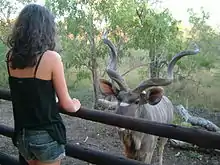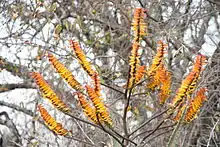Marloth Park
Marloth Park is a holiday town situated in northeastern South Africa in the Mpumalanga province (formerly Eastern Transvaal).


Marloth Park | |
|---|---|
 Marloth Park from the Kruger | |
 Marloth Park  Marloth Park | |
| Coordinates: 25°20′36″S 31°46′58″E | |
| Country | South Africa |
| Province | Mpumalanga |
| District | Ehlanzeni |
| Municipality | Nkomazi |
| Established | 1977 |
| Area | |
| • Total | 17.50 km2 (6.76 sq mi) |
| Population (2011)[1] | |
| • Total | 1,000 |
| • Density | 57/km2 (150/sq mi) |
| Racial makeup (2011) | |
| • Black African | 30.8% |
| • Coloured | 0.5% |
| • Indian/Asian | 0.8% |
| • White | 67.4% |
| • Other | 0.5% |
| First languages (2011) | |
| • Afrikaans | 48.1% |
| • Swazi | 22.8% |
| • English | 21.3% |
| • Tsonga | 2.9% |
| • Other | 4.9% |
| Time zone | UTC+2 (SAST) |
Geography
On the bank of the Crocodile River between Malelane and Komatipoort on the N4 national highway, Marloth Park is a wildlife sanctuary and holiday town. It boasts four of the “Big Five” with the exception of elephant. Buffalo, rhino and lion are confined to Marloth's game reserve "Lionspruit"; the rest of the game such as kudu, zebra, giraffe, blue wildebeest, nyala, impala, warthog, ostrich and others aren't restricted by fences and roam freely between the units that are built on 3000 ha.[2]
On the southern boundary of the Kruger National Park, Crocodile Bridge gate is 14 km and Malelane gate 35 km from Marloth Park.
History
The name Marloth Park derives from a German botanist, Rudolf Marloth. The Aloe marlothii was named after him. This plant is found abundantly in the lowveld.[3]
Marloth Park was founded in 1977.
Tourism
Marloth Park is a stopover point for tourists travelling to the Kruger National Park, to Mozambique or to Eswatini. Many lodges and private houses are found inside the Park.
Marloth Park is a unique project. It opened in 1972 as a holiday township, though a large part of the park remained natural. There are no internal fences and the vegetation remains in its original state. Marloth Park is separated by a boundary fence and by the Crocodile River from Kruger Park. Within the park, there are giraffe, wildebeest, kudu, zebra, impala, bushbuck, warthog, baboon, vervet monkey and other small game and a rich bird life. Meanwhile, the infrastructure of the natural park is well developed.
Inside Marloth Park (3,000 hectares), the freedom of movement is remarkable. Tourists can ride a bicycle or go for a walk on their own through the African bush. Movement is not confined to the housing units. While walking along the Crocodile River, visitors can watch spectacular wildlife scenes in the adjacent Kruger National Park. Local restaurants, shops and a filling station are easily accessible.
Sometimes, lions are roaming into Marloth Park, coming from the Kruger.[4]
Climate
Marloth Park features a humid subtropical climate with mild winters and hot summers.
References
- "Main Place Marloth Park". Census 2011.
- umjindi.org-"Archived copy". Archived from the original on 2011-10-08. Retrieved 2011-08-24.CS1 maint: archived copy as title (link) wild frontier
- Bredenkamp, G.J. & Van Vuuren, D.R.J. 1987. Note on the occurrence and distribution of Aloe marlothii Berger on the Pietersberg Plateau. South African Journal of Science 83: 498- 550
- Lions roam the streets of Marloth Park
External links
![]() Media related to Marloth Park at Wikimedia Commons
Media related to Marloth Park at Wikimedia Commons
.svg.png.webp)